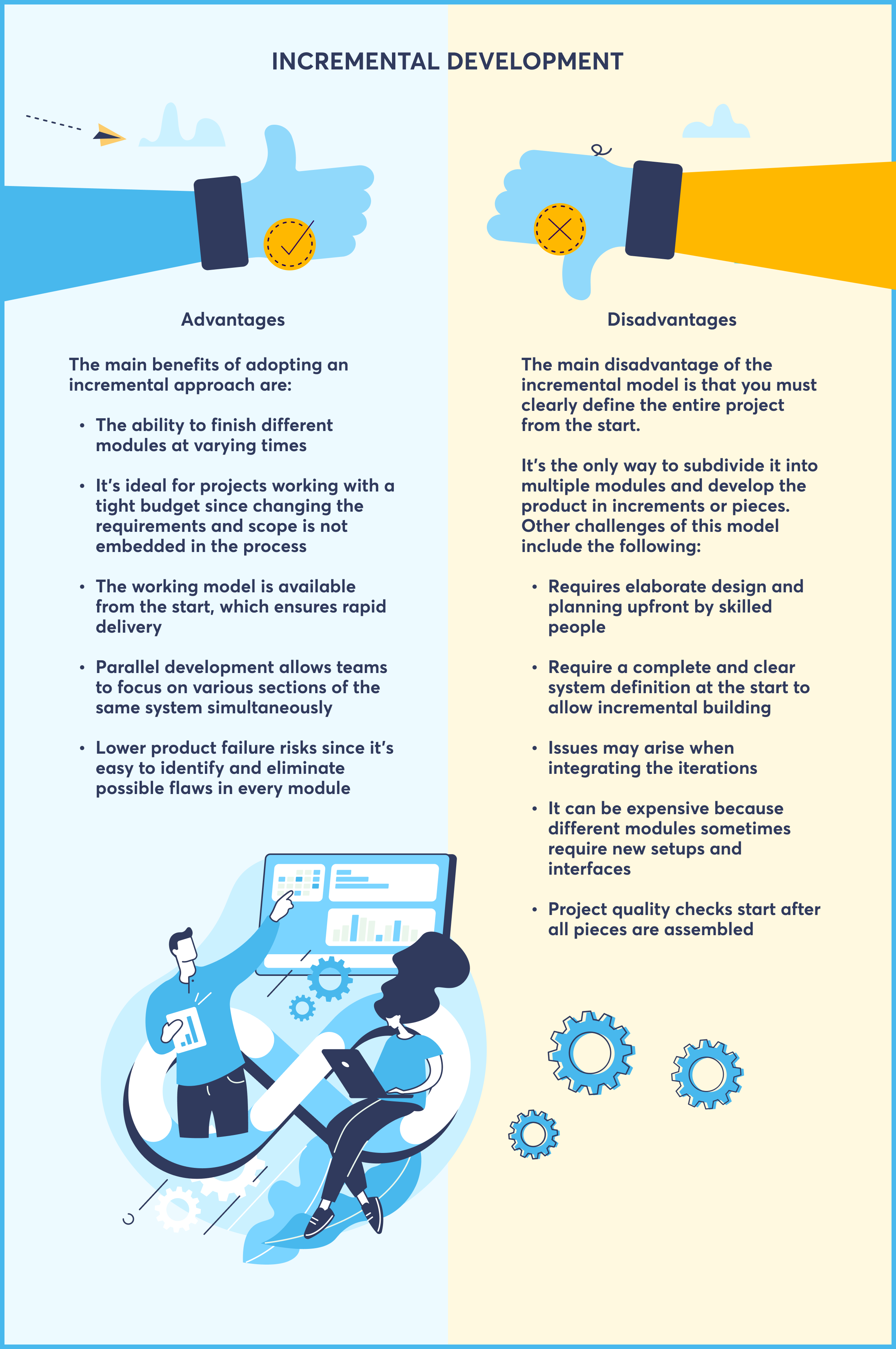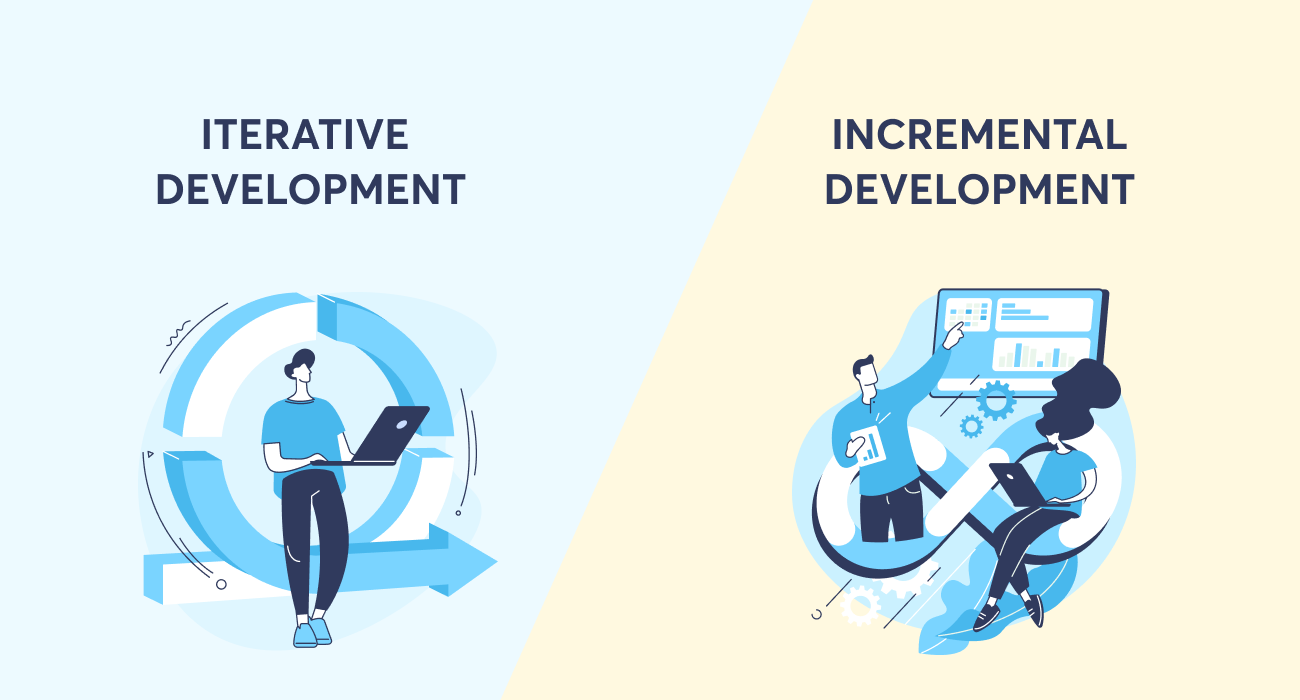At the start of any software development project, the team has to select the appropriate development method. The method should incorporate the client’s requests and the product specifications.
Although several methods are available, most teams choose the incremental or iterative framework. Understanding how they work will help you and your team select the most suitable process for your development needs.
Let’s dive in, shall we?
What Is Iterative Development?
In the dynamic business world, needs are ever-changing, so you require a strategy that accommodates the following:
- Frequent customer feedback
- Ability to integrate changes at any phase or stage of development
- Strive for the highest level of product quality
Iterative development achieves these precise requirements. The development process involves short iterations with customer collaboration during each iteration.
The iterative model subdivides the project into minor cycles to allow for iterative improvements and changes with each cycle. Your team starts with a general idea of the finished product and builds one layer over another until they achieve the desired product result.
Using the iterative approach, your team constantly has something to offer with each release. Once the team gets the feedback, they continue enhancing the unfinished work. This allows constant evaluation along the development process until you get the final product.
With iterative development, every product begins with a vision you gradually fulfill in the process. The model depends on a team that develops a program, gains as much knowledge as possible then advances to the next, better phase.
The Benefits of Iterative Development
With iterative development, your team constantly designs, creates, and tests the product. After every iteration, the team collects stakeholder and user feedback. They leverage these insights to create or design the next product iteration.
Iterative development allows teams to evaluate and adjust their methods, ensuring continuous improvement. This model has several benefits for different projects, including:

When to Use the Iterative Approach
Numerous things can affect product delivery. The iterative approach is ideal for projects that involve regular deliveries. Such projects include repeated activities that need constant checking and improvement.
Iterative development allows your team to focus on collecting feedback and requirements. It involves a continuous cycle of:
- Planning
- Designing
- Implementing
- Testing
- Evaluating
The iterative model applies to projects with tight deadlines to shorten the app’s time to market. The features can advance with time since your team can finish only some feature capabilities with each release.
You should use this approach when:
- You’re handling a large project
- You anticipate future product changes
What Is Incremental Development?
Incremental development involves developing a product in small portions, every piece individually. The team gradually builds functionalities until they achieve the final product. The client only sees the product after completion.
In the Incremental model, your team clearly understands the project goals and final product. The project is in increments or sections that complement each other. Your team adds one after the other until they get the whole puzzle completed.

When to Use the Incremental Approach
Incremental development is ideal for projects involving small deliveries of clear and fixed scope.
You can use this model when:
- The objectives and requirements are clear
- The project requires new technology
- Your industry involves high-risk objectives and opportunities
- There’s high demand for the product, so you need fast market entry
Iterative vs Incremental Development
There are some notable differences between the incremental and iterative development processes, including:
1. The Approach
The iterative model subdivides the development process into separate, fully-functional sprints or cycles. Doing so allows your team to present a working product before making adjustments to create a better iteration.
On the other hand, the incremental model allows the development of the final product in small increments or incomplete parts. The final functional product is only available at the end of the process when the incomplete parts come together.
2. Error Identification
In iterative development, it’s easier to identify errors because every iteration is independent. This allows you to begin reviewing the developed capabilities to pinpoint flaws or errors which can be corrected during the next iteration.
Each project phase is complete with incremental development but often can’t function independently. This means your team cannot identify errors or flaws until the end of the project when they integrate all the parts to create the final product.
3. The Completion Time
The iterative model leverages fast-paced sprints to finish every cycle. This allows you to swiftly create a product while reviewing the key features and capabilities of the final product.
With the incremental model, it takes a longer duration to finish a product. This is primarily because every section your team focuses on is only one portion of the product’s development cycle.
4. Product Quality
Iterative development focuses on ensuring quick product variations, one following the other. Your team is, therefore, likely to develop several unpolished or low-quality versions of the final product. They make improvements over time until they achieve the final high-quality product.
In contrast, if your team used the incremental model, they could develop a higher-quality product after the first cycle. They would achieve this by focusing all efforts on producing one refined version with a single end-to-end verification cycle at the end.
5. Costs
The iterative method can become too expensive since every iteration requires funding and it is not always known upfront how many iterations it will actually take. Although this may be fine at the beginning of the project, you’ll have to keep expanding your resources and budget.
Most people find the incremental method more cost-effective. Your team can utilize the entire budget on one iteration, so any extra costs will be for slight alterations or modifications when the scope is properly estimated and managed.
6. Risk Mitigation
The iterative method is more suitable when reducing the risks of a project. Your team can run regular product tests on every iteration and make the necessary changes. This fixes any previous issues to ensure the final iteration is nearly flawless.
The incremental method has higher risks because your team can only run product tests once they have the final product in the final cycle. Furthermore, the process takes longer to complete.
7. User or Client Engagement
The iterative method emphasizes more on user engagement. The client can test every product iteration and share opinions. These regular reviews empower your team with vital feedback throughout the entire process.
Conversely, the incremental method allows minimal user engagement. The client only gets to test the product at the final stage of the development cycle.
8. Change Implementation
The iterative model enables incorporating regular changes. The development team can easily add new product changes during the following iterative cycle.
In contrast, the incremental model is more rigid because the team can only make changes at the final stage of the development process. The areas of improvement become clear after the customer review, and quality assurance testing stages start.
9. Adaptability
The iterative model is more suitable for unexpected situations. In unforeseen events, your team can adapt to the new position during the next iteration.
In comparison, the incremental model falls short when embracing change. The development process abides by a specific process all through. Any unexpected changes will only delay the whole development cycle.
Incremental vs Iterative Development, which is better?
Iterative and incremental approaches ensure that the software development process remains smooth and effective.
Incremental development allows your team to make adjustments early on. There’s no need to wait till the final stage when you’re out of time and money for the project.
Iterative development ensures continuous improvements. Therefore, your team will likely deliver a higher-quality product on time.
The most suitable approach for your project depends on your case because both have pros and cons. However, this shouldn’t limit you to one approach per project.
In fact, iterative and incremental methods work well together toward the same result in agile development. Agile development balances both approaches. Their characteristics complement each other to enhance the entire process.
For instance, you can test and release a beta version of the final product before the full launch. Early feedback from the client or users will help you reduce the risk of removing a flawed final product.
Our approach is to evaluate the needs of the client to select the best solution based on their use case. Contact Sphere Partners today to find your custom software development solution.





